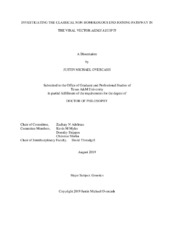| dc.contributor.advisor | Adelman, Zachary N | |
| dc.creator | Overcash, Justin Michael | |
| dc.date.accessioned | 2019-11-25T22:43:22Z | |
| dc.date.available | 2021-08-01T07:33:21Z | |
| dc.date.created | 2019-08 | |
| dc.date.issued | 2019-08-15 | |
| dc.date.submitted | August 2019 | |
| dc.identifier.uri | https://hdl.handle.net/1969.1/186550 | |
| dc.description.abstract | Aedes aegypti is a critical viral vector and is known to transmit yellow fever, dengue and Zika viruses. Current control mechanisms rely heavily on source removal and insecticide use making novel genetic control mechanisms an attractive alternative. The CRISPR/Cas9 system enhances basic and applied research by allowing for sequence specific genetic modification. Utilization of the CRISPR/Cas9 system relies on repair of DNA double stranded breaks by endogenous DNA repair pathways such as the classical non-homologous end joining (C-NHEJ) or homology directed repair (HDR). Manipulating the C-NHEJ pathway to increase rates of HDR would expedite experiments which rely on site specific integration of genetic constructs. To investigate the C-NHEJ pathway we aimed to create a luminescence-based assay to quantify shifts in end joining based repair and knockout the C-NHEJ genes ku70 and lig4 in the Ae. aegypti LVP strain. Using a GFP-firefly luciferase fusion protein, we created a luminescence-based assay which quantifies shifts in error-prone end joining repair in both Ae. aegypti embryos and cell lines (Aag2 and A20). Knockout of ku70 resulted in female-specific pupal lethality, reduced longevity in both male and female adult populations and delayed chorion melanization.
After maintaining mutants ku70-/- for 25 generations, no shift in either the single strand annealing pathway (SSA) or NHEJ was detected in ku70-/- embryos. While no shift in SSA or C-NHEJ was detected in ku70-/- embryos, ku70-/- larvae were significantly more sensitive DNA DSB generated by the DNA DSB inducing antibiotic bleomycin when compared to our LVP strain (p<0.01, compared to ku70-/- G0s (66% vs 4.1%). The results of knockout of lig4 and ku70 suggest that CNHEJ plays an important role in both fitness and DNA damage sensitivity. Additionally, creation of the NHEJ assay will allow for future high throughput analysis of additional genes involved in DNA DSB repair in both Ae. aegypti embryos and cells. This work will hopefully aid in future DNA damage repair studies which may be used to improve both basic and applied research in Ae. aegypti. | en |
| dc.format.mimetype | application/pdf | |
| dc.language.iso | en | |
| dc.subject | Classical non-homologous end joining | en |
| dc.subject | Homology directed repair | en |
| dc.subject | Alternative non-homologous end joining | en |
| dc.subject | double stranded break | en |
| dc.subject | clustered regularly interspaced palindromic repeat | en |
| dc.subject | high resolution melt curve analysis | en |
| dc.title | INVESTIGATING THE CLASSICAL NON-HOMOLOGOUS END JOINING PATHWAY IN THE VIRAL VECTOR AEDES AEGYPTI | en |
| dc.type | Thesis | en |
| thesis.degree.department | Entomology | en |
| thesis.degree.discipline | Genetics | en |
| thesis.degree.grantor | Texas A&M University | en |
| thesis.degree.name | Doctor of Philosophy | en |
| thesis.degree.level | Doctoral | en |
| dc.contributor.committeeMember | Myles, Kevin | |
| dc.contributor.committeeMember | Merlin, Christine | |
| dc.contributor.committeeMember | Shippen, Dorothy | |
| dc.type.material | text | en |
| dc.date.updated | 2019-11-25T22:43:22Z | |
| local.embargo.terms | 2021-08-01 | |
| local.etdauthor.orcid | 0000-0002-0084-169X | |


